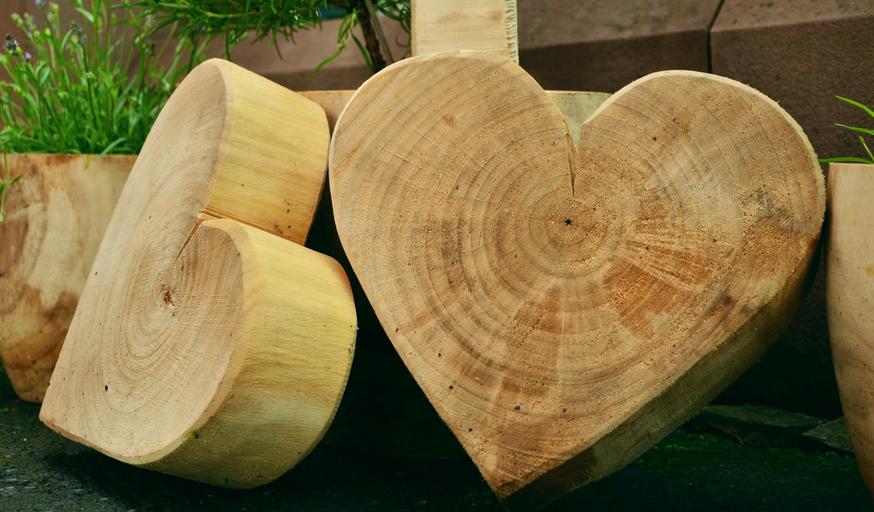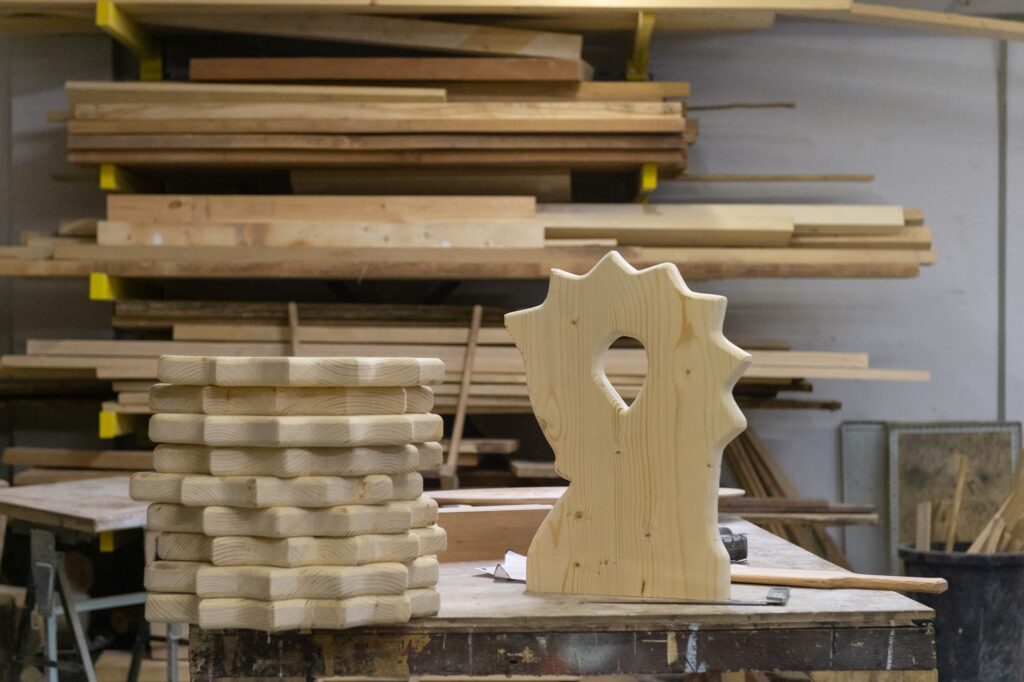One of the first steps for a beginner woodworker is to figure out what kind of wood you are going to be using.
The world is full of a variety of trees, which can make it overwhelming for beginners to choose what type to start out with.
If you’re carving, you’re definitely going to be working with a harder kind of wood, like Basswood or Aspen.
Softer woods, such as Douglas Fir or Eastern White Pine, are generally used for furniture and heavy construction.
Buying and using lumber is one of the easiest ways to begin your woodworking project.
Here’s the Answer to Whether or Not Lumber is Woodworking
Lumber is wood processed into standard sizes which are normally used in woodworking for larger projects such as furniture, general and heavy construction, boatbuilding, etc. Carpenters, joiners, and woodworkers alike use different kinds of lumber for some project or another in their career/hobby.
Table of Contents

What is Lumber in Woodworking?
By definition, lumber is wood that has been processed and cut to standard sizes to be sold commercially.
Lumber is used by carpenters, joiners, and woodworkers, and is usually vital to a project.
Various densities of wood and lumber can be used to make almost anything under the sun, including but not limited to; houses, boats, furniture, commercial buildings, flooring, paper and stationery, saunas, wooden sculptures, and musical instruments.
Whether it’s softwood or hardwood, lumber can be made out of almost any type of wood.
Is Lumber a Good Wood to Use in Woodworking?
It really depends on the project. Some projects call for timber, some call for lumber, and some call for both.
Lumber is a generalized term that can be used to cover a multitude of wood-types, ranging from softwood to hardwood.
Timber, on the other hand, is considered to be unprocessed wood, and can also refer to trees that are still standing.
For larger projects that need softwood, such as house development, lumber is the perfect material to use for just about everything in that project.
Smaller projects that need hardwood and don’t need to be made from lumber, such as carving, are normally worked out of cut timber or hardwood leftovers.
Lumber is a good wood to use in woodworking, you simply must be informed on what types of lumber there are and what you need for your project.
Can Any Lumber Be Used for Woodworking?
Yes, any type of lumber can be used for woodworking. It must be suitable for your project, though.
There are over 60,065 tree species in the entire world, which can give you a headache if you have to choose what’s best for what you want to make.
Ranging from the Australian Buloke (the hardest wood in the world), to Balsa wood (the softest wood in the world), you have quite the options on what wood you’re going to work with.
If you’re a woodworker that works primarily with smaller projects, knowing the odds and in’s of hardwood would be beneficial for you. General knowledge of softwood would also be a plus, just in case you wanted to step out of your field.
As far as carpenters go, you’ll want to be knowledgeable on the different types of softwood, while also keeping in mind what hardwood could be used for.
While any lumber can be used for woodworking, be careful and stay up to date on your knowledge of the various uses of lumber and timber.
What are the Different Types of Lumber for Woodworking?

All woods are categorized by two main types: hardwoods and softwoods.
Hardwood is wood from dicot trees that are usually broad-leafed. This includes Oak, Hickory, Teak, Maple, Basswood, and Aspen trees.
In contrast, a softwood that’s normally used is found in conifers, such as Douglas Fir, Eastern White Pine, Spruce, Redwood, Ponderosa Pine, and much more.
Lumber can also be distinguished from what has been done to the wood, how the wood has been cut, and the different grades that help determine what you’ll need for a project.
Framing and structural lumber, appearance boards, plywood, MDF, decking, and fencing, pressure-treated, and untreated lumber are most of the differentiating categories of lumber you’ll use in your woodworking hobby or career.
Framing and structural lumber
Structural lumber is the 2-foot x 4-foot and 4-foot x 4-foot boards commonly used in construction or even your own at-home DIY building projects.
All lumber used for framing and structural builds must follow standard building dimensions which allows for a faster work experience because you don’t have to trim as much.
Appearance boards
Appearance boards are used for exactly as they’re named: appearance. It doesn’t really matter how strong the original material is; all that’s valued is how they look.
There are a couple of grades of appearance boards, which are “Select” and “Finish”. Select is defined as the lower grade of the two, while Finish is obviously more of a high-end finish.
Appearance boards are perfect for small DIY projects around the home, decoration builds, flooring, and more.
Plywood
This kind of lumber should sound familiar to even the most remotely attuned woodworking ear.
Plywood is created by putting heat and pressure on very thin layers of wood to create a plank.
It’s normally untreated, but it can be decorated however you like and used for easy furniture projects, under-mattress boards, simple DIY builds, and shelving.
MDF
MDF stands for “Medium Density Fiberboard”. It’s basically resin that ties a mixture of softwood and hardwood together.
It’s dense, but it’s not water resistant.
MDF lumber is commonly used for furniture, cabinet-making, drawers, and shelving.
Decking and Fencing
While there are several materials available to build your decks and fencing, wood-built can be way more cheaper than the other options.
Deck and fencing lumber ranges anywhere from balusters, floor boards, railings, etc.
You can find these boards treated with ground contact treatment if you are putting posts in the ground.
Pressure-treated
Pressure-treated lumber is simply wood that’s been infused with preservatives to last longer than the average life span of natural lumber.
It’s usually used for decking and fencing, but it’s the more expensive kind and can be used in other projects as well.
Untreated lumber
This type of lumber is known to be used more with projects meant for children, plants, and animals.
It’s not given the harsh chemical treatments that children, plants, and animals might be harmed by.
Untreated lumber tends to keep the wallet heavy, as it’s cost-efficient when there are no expensive chemical compounds imbued in it.
What are the Pros & Cons of Using Lumber for Woodworking?
As with anything in this world, there are good and bad sides to using lumber.
Having the right knowledge when deciding to use lumber for your project is vital before you begin.
Pro’s
- Standard sizing makes for a faster project
- Can be found easily at your local hardware store or a lumber mill
- Most treated lumbers will last longer due to chemical preservatives
- Can easily be replaced if damaged
Con’s
- You might not be able to find the exact shape for your project
- Harder to find rare lumber as commercially inexpensive, lumber is easier to come by
- Lumber that you find might not be the quality you were promised
- Chemically treated lumber can cause damage to the environment around you
Is Lumber for Woodworking Expensive?
Lumber for your woodworking project might be easy to find, but hard to buy.
Prices depend on what type of lumber you’re buying, the quality/grade of it, and who you’re buying it from.
Most chain hardware stores such as Home Depot and Lowe’s carry decent quality wood at an affordable to semi-affordable price tag.
Lumber mills also give away wasted wood at a discounted price if you’re not looking for strictly straight wood.
How Do You Choose Lumber for Woodworking?
You choose lumber for woodworking by knowing what your project is and what type of wood it will need.
Will your project need hardwood or softwood? What kind of quality is your work needing to reflect? How stable will your project need to be?
All these questions need to be answered solely by you, because you know your project better than anyone.
Just make sure you know what type of wood will give you a particular outcome, and you’ll be on your way.
How Do You Buy Lumber for Woodworking?
After you know what kind of lumber you’ll be using, measure how much you’ll need for your project overall, plus some room for mistakes.
You’ll want to make sure to calculate how much your project will cost by checking the price where you’ll be purchasing the lumber, and cross referencing it at stores where it might be cheaper.
Once you figure out when and where you’ll be getting your wood, it’s best to give the store a courtesy call if you’ll be buying a sizable amount of lumber from them, just to make sure they have what you need. Pick up the lumber when you’re completely ready to start building.
Before you know it, you’ll be on your way to completing your next woodworking project.
